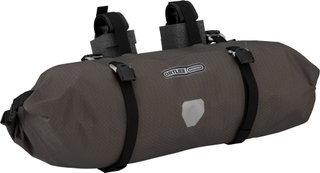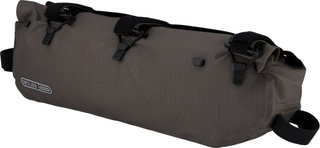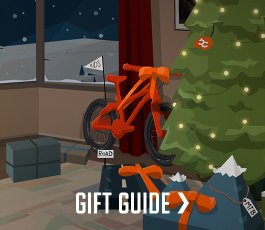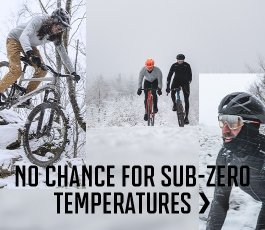Bikepacking • Accessories
OUR Bikepacking • Accessories RECOMMANDATIONS
Our Suggestions
Unlike a traditional bike trip, you don't store your bikepacking equipment in large panniers, but directly on the bike. This maintains driving dynamics and fun – even off-road or at high speeds and off the beaten track. The general rule for equipment is simple: less is more! The less weight you carry on your bike, the more pleasure you will have.
Bikepacking: Which bike?
Gravel or mountain bikes are especially good for bikepacking. They are robust, suitable for off-road use and offer enough space for your equipment. In principle, however, every bike can be a bikepacking bike. Just attach the bikepacking bags, load your gear and off you go on your adventure.
Bikepacking: What do I need to bring?
As little as possible, as much as necessary! A bikepacking adventure in the Scottish Highlands naturally requires different equipment than the quick after-work adventure. You can divide the equipment you need into the following categories:
- Transport: Bikepacking bags, etc. Here you can store everything you want to take with you
- Sleeping: Bikepacking tents, sleeping bags, camping mats, etc. If you make your bed, you lie in it.
- Repairs: Everything you need to have on hand to stay mobile. Don't just think about your bike, but also about repair materials for your tent, camping mat and so on.
- Nutrition: If you eat at restaurants and visit supermarkets while on the road, you obviously don't need any cooking equipment. It's a different story for the self-sufficient solo adventurer. However, you should always make sure to have a sufficient water supply and pack enough (drink bottles).
- Hygiene and Personal Needs: So far, so clear!
1. Luggage Transport: Bikepacking Bags
The foundation of any bikepacking adventure lies in bikepacking bags. Here you can store everything you need while on the road. Depending on the position of the wheel, the following types of bags can be distinguished:
- Bikepacking Saddlebags: They differ from classic saddlebags by their size. You can store bulkier gear here with a volume of up to 20 litres.
- Bikepacking Frame Bags: These sit, as the name suggests, in the main frame and can hold a lot of (heavy) luggage with a favourable centre of gravity.
- Bikepacking Top Tube Bags: Mounted on the top tube and offer quick access to smaller items.
- Bikepacking Handlebar Bag: Usually it’s a handlebar roll in different widths. Accommodates light and large-volume gear.
- Snack Bag, Feed Bag, etc.: Everything you want to have handy goes in here. Snacks, camera, bear spray (for the Tour Divide). But be careful: too much weight can alter the steering behaviour.
- Rack Bags: Special pannier rack solutions for bikepacking will save you if you have to carry a lot of gear.
Waterproof bags, such as those from the bag and bikepacking specialist ORTLIEB, are a good choice especially in autumn or winter and for tours in bad weather. Alternatively, you can also protect your equipment in a stuff sack with a so-called dry bag (waterproof stuff sack).
You can find detailed buying advice on all types of bags and an overview of what luggage belongs where in our blog.
2. Sleeping: Bikepacking Tent, Sleeping Bag and Camping Mat
This is where things can get tricky. This is because sufficiently high weather protection, sufficient warmth and adequate comfort must be accommodated in a small area and as light as possible on the bike. What "sufficient", "enough" and "appropriate" mean for you and your cycling adventure, however, is a matter of personal preference. You should always pay attention to a few things:
- Tent: Waterproof is a must! The ground sheet and fly sheet should be waterproof. The ground sheet is subjected to even higher stresses. For the fly sheet, manufacturers use either polyurethane-coated (PU) polyester or siliconised nylon. Sil-nylon can be packed smaller, is lighter and more resistant to ageing, but is also more expensive. Dome tents stand freely, tunnel tents are very quick to set up. A spacious vestibule gives you room for your luggage. You can read all about tent materials, designs and technical terms such as "water column" in our blog post.
- Sleeping Bag: Mummy sleeping bags are the most versatile compromise between warmth and weight; blanket sleeping bags are something for specialists. Down or synthetic fibre is used as the filling material. Down can be packed very small, is lightweight and offers superior comfort. Modern synthetic fibres score with high robustness, especially in wet conditions, good thermal performance and favourable prices. If you want to know more about stuffing, chamber construction, stretch seams and what else makes a modern sleeping bag, then take a look at our detailed buying guide.
- Camping Mat: A sleeping system for bikepacking is not complete without the right camping mat. It warms where you compress the fill material of the sleeping bag and provides an extra barrier between your body and the cold ground. The most suitable mats for bikepacking are self-inflating mats with air/foam filling, which score points for their high comfort and low price, as well as their lightweight air chamber siblings with an extremely small pack size. You can read about how to find the right camping mat in our advice on camping mats. Tip: Don’t forget the pump sack for air chamber mats.
3. Small Parts for Bikepacking
Here you will find little helpers that can really come in handy before, during and after tours. These includes, for example, repair sleeves for tent poles or care products for your bikepacking equipment, plus useful accessories such as microfibre towels that can be packed especially small or seat cushions for nights around the campfire.
Advice
Tips and Tricks








































